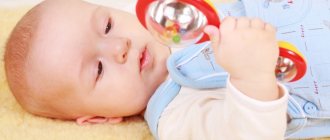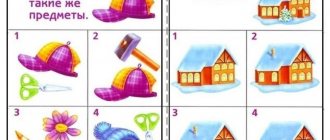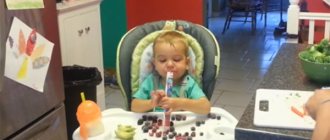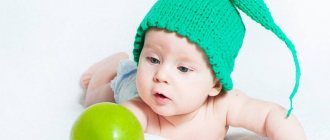Gymnastics is necessary for every person. At the same time, for babies in their first year of life, regular physical exercise not only helps them get stronger physically, but also has a beneficial psychological effect.
Exercise therapy for children under one year old, performed correctly and systematically, allows the baby to quickly begin to walk and talk. Interaction with loving parents improves mood, makes the child active and inquisitive. Of course, the necessary set of exercises and the correctness of their implementation must be monitored by a pediatrician; from the first months of life, physical education must be combined with massage, this allows you to relieve the increased muscle tone characteristic of infants.
Goals and objectives of exercise therapy for children
Exercise therapy is not only a set of exercises. The concept of physical therapy also includes massage, swimming, sun and air baths. Daily exercises tone up, improve metabolic processes, the baby develops better, and motor reactions develop.
Tactile contact during gymnastics and massage improves mood and evokes positive emotions.
Exercises are especially important for premature babies or children with health problems.
During gymnastics, the muscles are intensively supplied with oxygen, breathing becomes deeper, which means not only the muscles are strengthened, almost all systems of the body are actively involved in the process, including the brain. The baby learns to move correctly, roll over, and a little later crawl, begins to walk earlier and becomes more sociable. A set of exercises is selected taking into account the age and individual characteristics of the baby.
The main task of exercise therapy for children in the first year of life is to normalize the baby’s muscle tone and strengthen his body.
Important! Gymnastics exercises and massage are selected by a specialist, the first classes are carried out under the supervision of a pediatrician, you must strictly follow the doctor’s instructions.
All exercises are divided into reflexive, when the movements are performed by children unconsciously, passive, if the mother makes them for the baby, and active, if the child makes them himself.
https://youtu.be/yYAyeUa97Dg
Basic recommendations - what to do with a 5 month old baby
Walk
Every child needs a daily walk in the fresh air.
The ideal option is a two-hour exit to the yard, park or street in the mornings and evenings.
If in its first months the baby immediately falls asleep in the stroller, then at 5 months the baby enthusiastically begins to explore the world around him.
For this reason, it is advisable to use a seated stroller, placing the baby with his back to you.
Parents will be happy to notice changes in the baby’s behavior during a walk, as the five-month-old baby begins to look at the people around him, react to various sounds and watch the dog or cat.
One year old children like toys that make sounds. Musical toys for children under 1 year of age help not only to have fun, but also to learn.
Read about the features of raising children under three years old here.
Kids love water very much. That's why many parents buy a circle for bathing their newborns. Read about the features of using a circle in this publication.
Games
An entertainment program for a growing child is the second important component in the harmonious development of a five-month-old baby.
Magpie Crow
Finger folk game nursery rhyme
You should move your baby’s open palm (the porridge is cooking) and, slightly bending your fingers (you need to start with the big one), say:
The magpie-crow cooked porridge, fed the children, gave it to this one, gave it to this one, - Where were you? He didn’t chop wood, he didn’t light the stove, he didn’t cook porridge, he came later than everyone else.
Blind Man's Bluff and Hide and Seek
Where's the baby? The child should be called by name. Another adult covers the baby's eyes with his palms. They “look” for the baby for a long time and eventually find it.
Since a five-month-old baby cannot consciously hide, this game becomes a variation of the game called “Peek-a-boo” and hide and seek.
“Where is the nose, where is the mouth?”
The mother should ask the baby questions and show individual parts of the body one by one.
First on yourself, then on the child. For better understanding and awareness, it is advisable to show the baby’s nose, mouth, eyes, eyebrows with his own finger.
As the child grows up, he will remember this game, and in the future he will be happy to independently demonstrate his own body parts.
“What does the animal say?”
Imitating a cow, dog, cat, frog and other animals has a positive effect on the early development of a five-month-old baby. The baby enjoys emotional contact with adults and receives a lot of positive impressions.
In addition to games, the baby should read rhymes and nursery rhymes, tell short stories and talk to him often.
Bathing
Daily water procedures are important in a baby’s life.
But the main difference between five months of age is that the baby does not want to swim, lying in the bath.
He splashes the water with his palms with great pleasure, tries to catch a washcloth or soap bubbles with his hands, tries to stand up and does any other actions that interfere with the calm process of bathing.
Toys and special waterproof books are ideal as a distraction maneuver. They will attract the baby's attention and allow the mother to quickly bathe the baby.
Dream
At five months, infants' night sleep normalizes: they no longer wake up so often and allow their mother to get a good night's sleep.
The baby begins to be more awake, and the time allotted for sleep gradually decreases: during the daytime rest, the baby sleeps no more than two or three times.
Naturally, there are no exact rules or strict recommendations for the sleep of five-month-old babies: a lot depends on the character and other individual characteristics of the baby.
Children's gymnastics allows the child to develop physically, and the child also develops an appetite. Developmental gymnastics for children is selected depending on age.
The types of health-saving technologies that are used in kindergarten are described in this topic.
Nutrition
Strict breastfeeding (or artificial) feeding is gradually relegated to the background: the baby is given juices, vegetable and fruit purees and other types of complementary foods.
During feeding, the baby tries to make independent attempts to eat, tastes the food with interest, turns away from the dish he doesn’t like, showing his attitude towards the prepared food with all his appearance and actions.
No matter how parents develop a five-month-old baby, they should always encourage him, hug him more often, kiss him on the forehead or cheek, showing his love for him. A child should feel needed in the family!
The article lists general recommendations and necessary tips that will be useful to every parent, as well as people whose activities are in one way or another connected with young children.
Features of therapeutic exercises for children
Classes are held daily; exercises should not be performed immediately after feeding or if the baby is capricious and crying. There is no need to tire the baby too much; the load should increase gradually. Exercises begin after he is a month old; gymnastics always alternates with massage.
All exercises are performed carefully, gently, without unnecessary effort. During classes with your baby, you need to talk affectionately and smile, this will help the baby quickly get used to daily physical education, and will give you unforgettable moments of positive communication.
Important! A set of exercises along with a massage should not take more than a quarter of an hour.
If during gymnastics the child begins to act up, you should distract him, you can pause for a while and carry the baby in your arms or show him a bright toy. Not all children like to do exercises, but if classes are held daily, they quickly get used to it and stop worrying.
The tummy should be stroked only clockwise. Exercises that are especially unloved by the baby should be performed last; after gymnastics and massage, children fall asleep more soundly and calmly.
Of course, it is necessary to ensure that there are no drafts in the room; it is better to combine the complex with air baths; the temperature in the room should be 21-23°C .
If a child has health problems, conventional exercises are not suitable for him; in this case, the complex is selected individually and the exercises should be carried out by a physical therapy doctor.
Gymnastics for infants: video
Home » Baby massage » Gymnastics for infants: video
Properly selected physical exercises, in accordance with age and individual characteristics, affect the development of the central nervous system. In other words, the more the baby moves, the more varied his movements, the more favorable the conditions for the proper development of the brain.
Gymnastics for infants has a positive effect on the child’s physical and mental development and overall health. Exercises help deepen breathing, which develops and trains the lungs. Gymnastics has a beneficial effect on the baby’s appetite and sleep, and improves digestion. By increasing blood flow to muscles and bones, exercise promotes their growth.
In order for gymnastics to be useful for the baby, it is necessary to take into account the characteristics of the musculoskeletal system of infants. The baby’s muscles, ligaments, and bones are not yet fully formed, they are very delicate and fragile, so physical exercises should not exceed the child’s age capabilities.
Before you start doing gymnastics, you should first consult your doctor. It’s good if the doctor shows you several exercises and gives recommendations taking into account the child’s individual characteristics.
You need to do physical exercises every day, preferably at a certain time, so that the baby gets used to the regime. Classes should be conducted at a time when the baby is in a good mood, well-fed and calm. To ensure that gymnastics for infants does not provoke regurgitation, you do not need to start exercising immediately after feeding. The most favorable period for physical education is considered to be at least minutes after feeding or 20 minutes before it.
Gymnastics for a baby will be more beneficial if the baby is naked. Classes should be conducted in a warm (at least 20 ºС), well-ventilated room, and in the summer - in the fresh air.
It is better to do exercises on a table covered with a flannelette blanket, on which oilcloth and a diaper are laid. Before touching the child, you need to make sure that your hands are clean and warm. It is better to remove bracelets, watches, and rings so as not to accidentally injure the baby.
The easiest exercise that can be performed from the age of one month is rocking from side to side, up and down. While rocking your baby, carefully watch his facial expression. If you notice your baby's tension or anxiety, reduce the frequency of rocking or stop the exercise altogether.
It has long been known that the ability to use hands, especially fingers, is closely related to the intellectual and speech development of a child. The simplest exercises with bending and stroking fingers and palms like “Magpie-white-sided” will bring invaluable benefits to the child. Encourage your baby to open and close his fist, for example, by bringing his hand to your face or placing your finger in his palm. A useful exercise is rubbing the baby's arms from hand to shoulder. In this case, movements should be gentle and careful. After rubbing the handles, it is tedious to press them to your chest, lower them and lift them up and down.
Spreading on the tummy will reduce the baby's suffering from colic. With this exercise, first the baby will try to raise his head, and over time he will try to crawl, moving his arms and legs.
Exercises for babies from 1.5 to 3 months
Children of this age are characterized by increased muscle tone. At this age, experts recommend stroking parts of the baby's body and some irritating actions, to which reflex movements appear. For example, if you touch your baby’s feet with your palms, he will straighten his legs. The baby straightens his toes when pressing on the heel, and when pressing on the area at the base of the toes, he squeezes them.
Each exercise is performed 4-8 times, depending on the baby’s readiness.
1. Gymnastics for the arms
The child lies on his back. With light, stroking movements we move along the inside of the arm from the hand to the shoulder.
2. Gymnastics for the tummy
– We stroke the baby’s tummy in a circular motion, moving clockwise. – Place the baby on his stomach for a couple of minutes.
3. Gymnastics for legs
– Slightly lifting the baby’s leg, we stroke the outer and back sides of the thigh and lower leg, moving from the foot to the top.
– Lightly press on the base of the toes, then run the finger along the foot to the heel. This exercise is based on the plantar reflex and helps strengthen the muscles of the foot.
– Supporting the baby under the armpits, we place his legs on the table facing us. When the baby's feet touch a hard surface, the baby's legs straighten due to a reflex. Exercise strengthens the muscles and support of the legs.
4. Gymnastics for the back
– The child is lying on his side. Using two fingers, move along the spine from the buttocks to the shoulders, you initiate the spinal reflex - extension of the spine.
– Having placed the child on his stomach, stroke his back, moving from the butt to the neck and back.
– Lift the baby in your right palm, supporting his feet and legs with the other hand. This exercise is called "swimmer". While performing this task, the baby will tilt his head back and straighten his back.
Gymnastics for infants should be carried out in a favorable psychological atmosphere. To create a positive mood, talk to the baby and smile at him. Rhythmic rhymes and nursery rhymes have a positive effect on the baby’s emotional state. Over time, your baby will develop favorite poems to which he will respond with a disarming smile.
Category: Baby massage | Author: Pediatrician
Rules for conducting exercise therapy
A changing table or a regular table covered with a warm diaper is ideal for exercise. The main thing is a non-slippery, flat surface and the possibility of a free approach to the baby.
The person conducting the classes should wash their hands thoroughly, they should be clean, dry and warm, so as not to injure the baby’s delicate skin, cut their nails short, take off their watches and jewelry.
Classes begin no less than 45 minutes after feeding, the room in which the gymnastics will be carried out is thoroughly ventilated.
Each exercise is performed 3-5 times .
If the baby does not feel well or is very capricious, the procedure should be canceled until complete recovery and be sure to consult a pediatrician before resuming classes.
A baby older than 1 month can be completely undressed for classes; newborn children are covered with a diaper and places for massage are opened one by one. For babies, exercises are alternated with massage; for children older than 6 months, the necessary exercises are first performed, and the classes are completed with a massage.
As you get older, the exercises become more complex. Exercise therapy for children 1-2 years old contains exercises with toys; at this age it is quite possible to conduct joint exercises, setting a personal example for the child.
Exercise sets
All given sets of exercises and massage elements are recommended exclusively for healthy babies.
1-3 months
Only reflex exercises are performed with newborns. They are based on the use of the baby’s innate reflexes:
- Laying on the tummy. At the same time, the child reflexively turns his head to the side, and the muscles of the neck and back are trained. If at this time you place your palms on your heels, creating a slight emphasis, he will try to move forward.
- Stroking the feet. You should carefully run your finger along the child’s feet; he will clench and unclench his fingers.
- The baby is placed on its side and carefully rubbed with fingers on both sides of the spine, about a centimeter from the spinal column. At the same time, the baby stretches his back.
- Gently stroke the baby's arms and legs, from the toes up to the shoulders and hips.
- The baby is placed on his back, the legs are pulled up to the stomach, the arms are crossed on the chest, the head is also easily directed towards the chest. This pose is called "embryo". The baby should be secured for 0.5-1 minute.
- Holding the child under the armpits in a vertical position, the feet touch the table, and the baby will definitely begin to move his legs.
- From 2 months you can perform a “bicycle” with your child; the legs are bent at the knees, pulled up to the stomach and carefully “pedaled.”
Finish the gymnastics by stroking the tummy clockwise. This improves digestion and relieves the baby from colic. All exercises are done carefully and are accompanied by gentle speech and a smile.
4-6 months
The child has grown up, and the set of exercises becomes more complex. From 4 months you can swing him on a ball. The baby is placed on his tummy on a special ball with arms and legs spread out to the sides. Care must be taken that it does not slip off the ball. Then, the exercise is repeated with the child lying on his back. This type of gymnastics stretches the spine and strengthens the back muscles.
- Circular movements with your hands. The arms are crossed on the chest, then pulled up and returned through the sides to their original position.
- Turns on your stomach. They place a favorite toy on the side of the child and gently encourage the baby to turn in its direction, then help him roll over onto his tummy.
- Supporting the baby under the arms helps him sit down and then straighten up.
- The child is placed in the palm of his hand on his stomach, the baby’s legs rest against the chest of the person performing the exercises with him, and the baby is lifted up imitating an “airplane.”
The massage includes stroking, rubbing, and light tapping.
7-9 months
After six months, new ones are added to the familiar and favorite exercises.
- Allowing the child to firmly grasp your fingers, pull him up so that he resists while trying to sit up. You should not force your child to sit down, just provide him with support.
- With your baby on his stomach, lightly lift him up with your palms under his tummy, encouraging him to get on all fours. When the arms are strong enough, place a bright toy in front of the child so that the child can crawl to it.
- Game of "cars". The child is placed on his tummy, then his legs are raised so that he moves forward with his hands.
- When practicing on a fitball (special ball), you should rock the baby and support him by the legs and allow him to reach the bright toy lying near the ball.
A set of exercises at this age takes 30 minutes.
10-12 months
At this age, the baby is already moving very actively, many begin to walk.
The child should be encouraged to collect bright toys and put balls in a basket. If the child does not walk on his own, you need to lead him under the arms and organize joint crawling competitions.
Joint fiddling and climbing over a gymnastic stick placed on the floor strengthens muscles well. Of course, the baby should be supported, helped, and encouraged in every possible way.
Exercise therapy for 1-year-old children should not be tedious or too complicated.
Turn your activities into a game and then together with your child you will receive a lot of positive emotions.
Gymnastics and massage techniques
Foot massage to strengthen muscles:
- put the baby on his back;
- Stroking each leg 3 times;
- perform ring rubbing 3 times;
- iron the legs along the entire length;
- perform felting.
These manipulations must be repeated 3-4 times, alternating movements.
Exercise to strengthen the joints and muscles of the legs:
- lay the baby on his back;
- take the child by the legs (shin) and begin to bend and unbend them alternately;
- after this, you should begin to perform movements synchronously with both legs.
If your baby does not suffer from hypertension, then the legs can be brought up to the tummy.
Reflexive foot massage:
- the baby lies on his back;
- stroke the feet;
- start rubbing;
- stroke;
- tap.
These manipulations must be alternated at least 4-5 times.
Hand massage:
- First, stroke your hands;
- start ring rubbing.
These steps must be performed at least 5 times.
Breast massage:
- baby on back;
- Make circular stroking movements from the ribs to the shoulders;
- stroke along the intercostal spaces;
- Repeat the vibration massage 3 times.
All manipulations must be alternated up to 5 times, and the session should end with stroking.
Circular rotations with arms and crossing arms:
- first give the baby your thumbs in his hands;
- when he holds them, spread his arms to the sides;
- then lift it to the top and bring it forward;
- cross the baby’s relaxed arms on his chest;
- do the exercises in the opposite direction.
Buttocks and back massage:
- place the baby on his stomach;
- stroke the buttocks and back;
- start pinching and rubbing.
This massage technique can be used in children from the first months of life.
Turn from back to stomach and in the opposite direction:
- place the child on his back;
- slightly move the baby's leg to the right;
- give him a little push that he made a coup.
This exercise can be done with a baby from two months. At the age of five months, you can “force” the child to roll over with the help of his favorite toy, placing it on his side and asking the child to reach the target.










